Bacterial fruit blotch of cucurbits
Acidovorax avenae subsp. citrulli (=
Pseudomonaspseudoalcaligenes subsp.
citrulli,
Pseudomonas avenae subsp.
citrulli)
watermelon, melon (cantaloupe, honeydew), cucumber, pumpkin, squash, gourds, citronmelon and other cucurbits
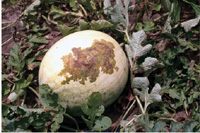
Mature watermelon fruit displaying typical bacterial fruit blotch symptoms including
irregularly shaped water-soaked lesions with cracks.
Symptoms and Signs
Bacterial fruit blotch (BFB) affects the foliage at all growth stages and fruit of a wide range of cucurbitaceous hosts. Symptoms can be initially observed on cucurbit seedlings, between five and eight days after planting; depending on the environmental conditions. For most cucurbits initial seedling symptoms include water-soaking on the undersides of cotyledons (Figure 2). High relative humidly during early morning hours can lead to natural water congestion of cotyledons that can mimic BFB seedling symptoms. However, unlike natural water congestion, BFB-associated lesions have a greasy appearance and persist under dry conditions, i.e., observable after mid-day (Figure 3). Water-soaked lesions start as discrete spots but then coalesce and extend along the veins of cotyledons. Lesions can extend along stems to tissues of true leaves and in severe cases they can cause seedlings to collapse and die in a "damping-off fashion." Water-soaked lesions eventually dry to form elongated, dark to reddish-brown lesions that develop on and along cotyledon veins (Figure 4). Similar symptoms are produced on melon (Figure 5) and other cucurbit seedlings.

Figure 2 |
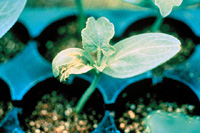
Figure 3 |
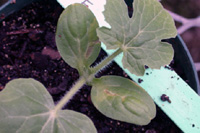
Figure 4 |
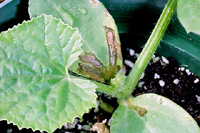
Figure 5 |
On mature watermelon foliage, distinct dark to reddish-brown lesions develop along leaf veins; however, these may be inconspicuous and indistinguishable from symptoms of other foliar diseases (e.g., anthracnose and gummy stem blight). On cantaloupe leaves, symptoms include tan to reddish-brown lesions along leaf veins (Figure 6), but also include v-shaped lesions that extend from the margin to the base of the leaf (Figure 7). BFB symptoms on pumpkin foliage also include elongated tan lesions along leaf veins (Figure 8), but extensive chlorosis may be present (Figure 9). Although symptoms include leaf spots, these may be inconspicuous and have little to no effect on the host plant. The economic loss results from the fruit rot phase of the disease.
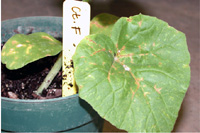
Figure 6 |
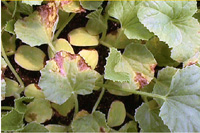
Figure 7 |

Figure 8 |
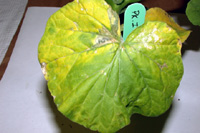
Figure 9 |
BFB symptoms on watermelon fruits appear just prior to harvest maturity as small (< 1 millimeter in diameter), irregularly-shaped, olive-colored spots on the upper surfaces of the fruit (Figure 10). These lesions, although initially small, can spread and cover the entire upper surface of the melon. At early stages of infection these lesions are firm and rarely penetrate into the flesh of the fruit. Brown cracks may develop in the rind lesions and they may release amber-colored or effervescent ooze (Figures 11 and 12). At advanced stages, fruits collapse into a watery rot due to invasion by secondary colonizing organisms (Figure 13). BFB symptoms on melon fruit also start as discrete dark green spots (Figure 14); however, as fruit mature, lesions become small sunken depressions in the rind (Figures 15 and 16). In melons that develop a netted rind (e.g., cantaloupe), the netting fails to develop over necrotic areas, resulting in smooth sunken spots (Figure 17). Melon lesions do not expand on the fruit surface, but penetrate through the pericarp (fruit wall) to cause rotten brown cavities (Figure 18). Similar symptoms occur on pumpkin including water-soaked lesions with cracks in the rind (Figure 19) and internal fruit rot (Figure 20).

Figure 10 |

Figure 11 |
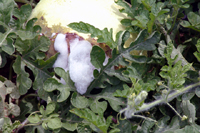
Figure 12 |
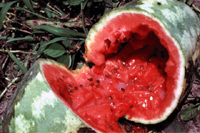
Figure 13 |

Figure 14 |

Figure 15 |
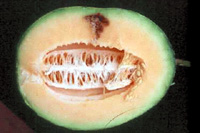
Figure 16 |

Figure 17 |
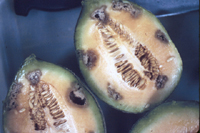
Figure 18 |
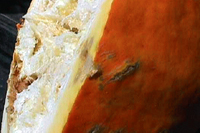
Figure 19 |

Figure 20 |
Pathogen Biology
Acidovorax avenae subsp.
citrulli is a gram-negative, rod-shaped, bacterium with average dimensions of 0.5 x 1.7 µm, and is motile by a single polar flagellum. The bacterium is strictly aerobic, positive for oxidase activity and grows at 41° C (106° F) but not 4° C (39° F).
A. avenae subsp.
citrulli grows on many general bacterial growth media and produces smooth, round, cream-colored, nonfluorescent colonies after 48 hr on King’s medium B (Figure 21). Using physiological characteristics , the pathogen was initially classified as a member of the group III pseudomonads and identified as
Pseudomonas pseudoalcaligenes subsp.
citrulli. Based on nucleic acid hybridization data, analysis of whole-cell protein and carbon substrate utilization profiles, the pathogen was reclassified as
A. avenae subsp.
citrulli.
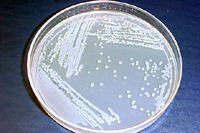
Figure 21 |
Originally
A. avenae subsp.
citrulli was reported to cause watermelon seedling lesions and blight, but no fruit rot. Additionally, the original strain recovered from plant introductions at the Georgia (GA) Agricultural Experiment Station did not induce a hypersensitive response (HR) on tobacco leaves. In contrast, strains recovered from the first BFB outbreaks in commercial watermelon fields in 1989 were HR-positive (5) and caused severe fruit rot. This discrepancy led to confusion about the identity of the causal agent of BFB. However, based on fatty acid analysis, DNA fingerprinting data (Figure 22), and carbon substrate utilization, it was shown that at least two distinct sub-groups of the pathogen existed . In general, group II strains are highly aggressive on watermelon , mildly aggressive on other cucurbits, and include strains that caused the original BFB outbreaks in commercial fields. In contrast, group I strains are mildly to moderately aggressive on a wide range of cucurbit hosts and include the strains that caused watermelon seedling blight on plant introductions at the GA Agricultural Experiment Station. This strain might have mutated to reduced aggressiveness, or it might represent a genetically distinct subpopulation. At present there is still much that is unknown about the biology of
A. avenae subsp.
citrulli.
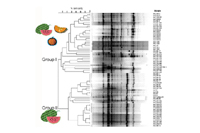
Figure 22 |
Disease Cycle and Epidemiology
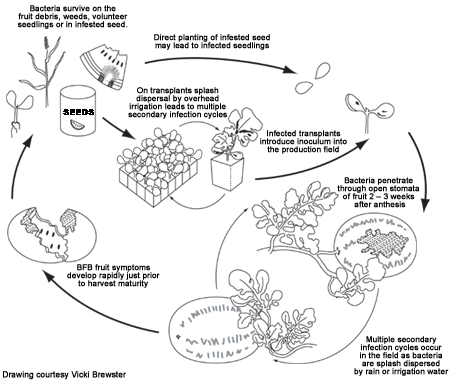
Disease Cycle
Seedborne inoculum is the most important primary inoculum source for BFB epidemic development. Seed of most, if not all cucurbits, can be infested and transmit BFB. Unfortunately, little is known about the biology of cucurbit seed infestation by
A. avenae subsp.
citrulli. Additionally, it is not known whether the pathogen survives on or under the seed coat. Seed within infected fruit become infested by contact with contaminated tissues; however, in commercial seed production, visual field inspection is conducted, and only symptomless fruit are used. Hence, the significance of infested seed produced in symptomatic fruit is questionable. Recently it was found that female watermelon blossom colonization could lead to seed infestation by
A. avenae subsp. citrulli although BFB symptoms did not develop on the fruit. This mechanism of seed infestation provides a possible explanation for the production of contaminated seedlots from visually inspected fields. Despite these findings the epidemiological significance of blossom colonization in seed infestation remains to be determined. While it is clear that infested seed are important for BFB outbreaks, other possible sources of inoculum exist, including volunteer seedlings, cucurbit weeds and decaying infested debris.
Direct planting of infested seed results in BFB seedling transmission under ideal environmental conditions. BFB seedling transmission is heavily dependent on high relative humidity; hence the risk of disease outbreak is reduced with direct seeding. Increasingly, commercial cucurbit production involves transplanting greenhouse-grown seedlings to the field to ensure rapid plant stand establishment. Transplant house conditions including high temperatures, high relative humidity, and high plant populations are conducive to BFB seedling transmission and rapid disease spread (Figure 23) . The exact mechanism of BFB seedling transmission is unknown, but bacteria move from seed to seedling tissues where they multiply in intercellular spaces and initiate water-soaked lesions. Bacteria in lesions are dispersed by overhead irrigation to seedlings throughout transplant house facilities. Splash-dispersed bacteria initiate secondary infections that are responsible for rapid epidemic development and high populations of infected seedlings. Even in the absence of symptoms, epiphytic
A. avenae subsp. citrulli populations may initiate BFB outbreaks under ideal field conditions. Because of these factors, the risk of BFB development is high, even for seedlots with low levels of contamination.

Figure 23 |
Under field conditions, high relative humidity and high temperature favor BFB development.
A. avenae subsp. citrulli is disseminated by wind-driven rain and irrigation water, and causes foliar lesions and blight symptoms. Infected vines are usually not killed by infection, and in most cases, symptoms on mature foliage are difficult to recognize. Foliar lesions and epiphytic populations serve as reservoirs for
A. avenae subsp. citrulli inoculum and contribute to secondary infections. The bacteria penetrate leaves via stomata and wounds and remain in the apoplast (intercellular spaces) of infected tissue (Figure 24). There is no evidence of systemic bacterial migration through the plant. For fruit infection, bacteria deposited on the rind of fruit two to three weeks after anthesis (flowering) swim through open stomata to initiate infections. After this period, stomata become blocked by the deposition of waxes on the fruit surface that prevent further invasion. Hence, mature fruit are generally not susceptible to natural infection by
A. avenae subsp.
citrulli unless wounding occurs.

Figure 24 |
During the early stages of fruit development, BFB symptoms are inconspicuous or absent, but appear suddenly at, or just prior to, harvest maturity. Surface lesions expand rapidly, and fruit may eventually rot in the field.
A. avenae subsp.
citrulli can overwinter in decaying infested rind tissues or in infested seeds that can produce volunteer plants in subsequent crops.
Disease Management
Since there are no resistant commercial cultivars, successful BFB management depends on exclusion of primary inoculum, cultural practices, and the use of copper-based bactericides. Currently, no single tactic is effective for managing BFB as the efficacy of chemical control depends on environmental conditions. Additionally, effective disease management must be practiced in seed and transplant production.
BFB management in seed production fields.
The most important management strategy for BFB is exclusion of
A. avenae subsp.
citrulli by using pathogen-free seeds and seedlings. It is impossible to guarantee pathogen-free seed, but seed health testing reduces the risk of outbreaks. Currently, the standard seed test for BFB is the seedling grow out assay (Figure 25) in which 10,000-30,000 seed/lot are planted under conditions conducive for BFB development. Seedlings are visually inspected after 18 days for BFB symptoms.

Figure 25 |
To reduce the risk of seed infestation, cucurbit seed are produced in dry, cool climates in regions of countries with no history of BFB (Figure 26), and 3- to 5-year crop rotations with non-cucurbit hosts are routinely practiced. Seed fields are visually inspected, and only seed from BFB-free fields are used.
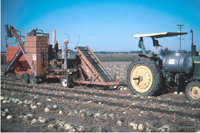
Figure 26 |
Currently, no chemical or physical seed treatments are 100% effective at eradicating
A. avenae subsp.
citrulli. While seed treatments including thermotherapy, NaOCl, fermentation, HCl and peroxyacetic acid significantly reduce BFB seedling transmission, they can adversely affect seed physiology. Two factors that influence seed treatment efficacy are: 1) the inability of seed treatments to penetrate the seed coat, and 2) location of bacteria on/in the seed. Because the risk of BFB development in transplant houses is high for seed with low levels of infestation, seed treatment alone cannot control BFB.
BFB management in transplant production facilities
To avoid introducing
A. avenae subsp.
citrulli into transplant houses, only tested, pathogen-free seed are planted. To minimize secondary pathogen spread, physical contact with seedlings is kept to a minimum, and sterilized transplant flats are used for each crop to limit the risk of carry-over contamination. Adequate fertilization and pest control programs are implemented to promote healthy seedling growth.
To prevent pathogen spread, traffic and the movement of equipment between houses is minimized. Ideally, seed from different lots should be planted in separate greenhouses; however, this is usually not feasible and instead, 60 cm (24 in.)-high plastic barriers should be established between plantings (Figure 27). If possible, ebb and flow irrigation should be used instead of overhead irrigation to reduce splash dispersal of
A. avenae subsp.
citrulli. However, this is cost prohibitive and rarely implemented. With overhead irrigation, watering should be done at mid-day to facilitate rapid drying of plant surfaces, and the water delivery pressure should be low to limit aerosol generation.
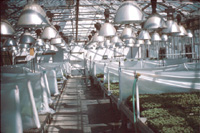
Figure 27 |
To facilitate early detection of BFB outbreaks, visual inspection of seedlings is routinely conducted. Since it is possible for
A. avenae subsp.
citrulli to survive epiphytically on asymptomatic seedlings, all seedlings produced in transplant houses with BFB should be discarded. This is a costly option since planting will be delayed and targeted market windows will be missed. Hence, in cases where it is economically unfeasible to discard exposed seedlings, symptomatic plants and those in the immediate vicinity should be discarded. The remaining seedlings should be treated with copper-based bactericides. Additionally, relative humidity in the transplant house should be reduced by increasing air-flow, and aggressive copper bactericide-based BFB management programs should be implemented in the field. After each seedling production cycle, transplant houses should be completely disinfested and left empty for at least two to three weeks before planting cucurbits.
BFB management in fruit production fields.
There are no commercial cucurbit cultivars with immunity to BFB. While several watermelon plant introductions are resistant, all commercial cultivars appear to be susceptible to the disease. To exclude
A. avenae subsp.
citrulli from commercial fruit production fields, tested seed and BFB-free seedlings are used to plant fields. Three-year rotations with non-cucurbit hosts are routinely employed. Debris, including watermelon culls from fields with BFB, is deep plowed at the end of each growing season. Subsequent cucurbit crops are established in new fields physically separate from the outbreak site. If possible, alternative hosts such as wild and volunteer cucurbits should be eliminated from regions around production fields and transplant houses.
For preventive management, biweekly applications of copper-based bactericides e.g., cupric hydroxide, copper hydroxosulfate, or copper oxychloride are employed at the recommended rate or weekly at half the recommended rate. Preventive sprays are initiated at or before anthesis (flowering) and continue until fruit are mature. If BFB symptoms develop, weekly applications of the full recommended rate of copper-based bactericides are employed. To prevent spread, work is not conducted in fields with BFB when the foliage is wet, and field equipment is decontaminated before moving between fields.
Significance
BFB has great potential to cause significant economic losses to cucurbit production, and has been responsible for up to 90% losses of marketable yield in some watermelon fields. BFB was first observed in 1965 on watermelon at the USDA plant introduction station, Griffin, GA, where it caused seedling blight symptoms. The disease was confined to seedlings at the station, suggesting that it was introduced by seeds of plant introductions. Furthermore, no outbreaks were reported in commercial watermelon fields during this period. By 1988, BFB outbreaks were observed in commercial watermelon fields in the Mariana Islands (in the North Pacific Ocean). In 1989 the first outbreak in the continental US was observed in Florida. It is clear now that the source of inoculum in the commercial watermelons was independent of the seedling blight outbreak at the USDA Plant Introduction Station in GA. Since 1989, BFB outbreaks have occurred sporadically in the major cucurbit-producing states in the US, with significant economic impact. Most notably, BFB caused significant losses in 1994 when the seedborne nature of the pathogen, along with the lack of adequate seed health assays, resulted in widespread outbreaks in Florida, Georgia, Indiana, South Carolina and Texas. These outbreaks brought national attention to BFB and highlighted the general threat posed by seedborne diseases. The repercussions of these outbreaks included direct economic losses, as well as costly lawsuits against seed and transplant producers. The economic magnitude of these lawsuits forced some seed companies out of business while others suspended watermelon seed sales in certain “high risk” states. Even today, some seed producers do not guarantee the performance of their seed in South Carolina for fear of litigation. Fortunately, with the implementation of routine seed health testing, many companies resumed the sale of watermelon seed with reduced risk of BFB transmission. Despite the implementation of routine seed health testing, sporadic BFB outbreaks continue to occur, and in 2000 and 2001 significant widespread outbreaks occurred across the US. Additionally, outbreaks have occurred on a wide range of cucurbit hosts in Australia, Brazil, China, Costa Rica, Israel, Japan, Nicaragua, Taiwan, and Thailand.
This wide geographical distribution of BFB indicates that seed is still an important primary inoculum source for BFB and suggests a need for improved management strategies.
To guard against costly lawsuits, seed producers now include a disclaimer with each watermelon seed package, stating that even though seeds have been tested, there is no guarantee that they are free of
A. avenae subsp.
citrulli. Additionally, at the time of seed purchase, growers are required to waive their rights [example of a watermelon seed purchase agreement (Figure 28)] to pursue legal action against seed producers in the event of a BFB outbreak.
Selected References
Hopkins, D., C. Thompson, J. Hilgren, and B. Lovic. 2001. Wet seed treatment with peroxyacetic acid for the control of bacterial fruit blotch and other seedborne diseases of watermelon . Plant Dis. 87:1495-1499
Hopkins, D. L. and C.M. Thompson. 2002. Seed transmission of
Acidovorax avenae subsp
citrulli in cucurbits. Hortscience 37:924-926.
Latin, R. X. and D.L. Hopkins. 1995. Bacterial fruit blotch of watermelon: The hypothetical exam question becomes reality. Plant Dis. 79:761-765.
Schaad, N. W., G. Sowell, R.W. Goth, R. R. Colwell, and R.E. Webb. 1978.
Pseudomonas pseudoalcaligenes subsp.
citrulli subsp. nov. Int. J. Syst. Bact. 28:117-125.
Somodi, G. C., J.B. Jones, D.L. Hopkins, R.E. Stall, T.A. Kucharek, N.C. Hodge, and J.C. Watterson. 1991. Occurrence of a bacterial watermelon fruit blotch in Florida. Plant Dis. 75:1053-1056.
Walcott, R. R., A. Fessehaie, and A.C. Castro. 2004. Differences in pathogenicity between two genetically distinct groups of
Acidovorax avenae subsp.
citrulli on cucurbit hosts. J. Phytopathology 152:277-285.
Webb, R. E. and R.W. Goth. 1965. A seedborne bacterium isolated from watermelon. Plant Dis. Rep. 49:818-821.
Willems, A., M. Goor, S. Thielemans, M. Gillis, K. Kersters, and J. DeLey. 1992. Transfer of several phytopathogenic
Pseudomonas species to
Acidovorax as
Acidovorax avenae subsp.
avenae subsp. nov., comb. nov.,
Acidovorax avenae subsp.
citrulli,
Acidovorax avenae subsp.
cattleyae, and
Acidovorax konjaci. Int. J. Syst. Bact. 42:107-119.
